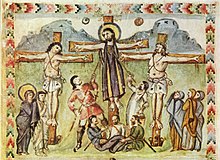
Back لونجينوس (شخصيه من العهد الجديد) ARZ Longinus BCL Святы Лангін Byelorussian Лонгин (светец) Bulgarian Sant Longí Catalan Longin Czech Sankt Longinus Danish Longinus German Άγιος Λογγίνος ο Εκατόνταρχος Greek Longinos (centurión) Spanish
Longinus | |
|---|---|
 Statue of Saint Longinus by Bernini in Saint Peter's Basilica | |
| Born | 1st century in Sandiale or Sandrales[1] of Cappadocia[2] |
| Died | 1st century |
| Venerated in | Anglican Communion Eastern Orthodox Church Oriental Orthodoxy Catholic Church |
| Major shrine | Inside St. Peter's Basilica, Vatican City |
| Feast |
|
| Attributes | Military attire, lance[3] |

Longinus (/lɒnˈdʒaɪnəs/) is the name given to the unnamed Roman soldier who pierced the side of Jesus with a lance; who in medieval and some modern Christian traditions is described as a convert to Christianity.[4] His name first appeared in the apocryphal Gospel of Nicodemus.[5] The lance is called in Christianity the "Holy Lance" (lancea) and the story is related in the Gospel of John during the Crucifixion.[6] This act is said to have created the last of the Five Holy Wounds of Christ.
This person, unnamed in the Gospels, is further identified in some versions of the legend as the centurion present at the Crucifixion, who said that Jesus was the son of God,[7] so he is considered as one of the first Christians and Roman converts. Longinus' legend grew over the years to the point that he was said to have converted to Christianity after the Crucifixion, and he is traditionally venerated as a saint in the Roman Catholic Church, Eastern Orthodox Church, and several other Christian communions.
- ^ "Sandrales/Sandiale: A Pleiades place resource". 23 July 2012.
- ^ "Pago autem nomen est Sandiale" "Σανδιάλη τῇ κώμῃ τό ὃνομα" from «month March» ΙΑ' page. 41 (in pdf page 17). Archived 1 Jul 2016. Retrieved 6 Feb. 2018
- ^ Stracke, Richard (2015-10-20). "Saint Longinus". Christian Iconography.
- ^ Fuhrmann, Christopher (11 April 2014). Policing the Roman Empire: Soldiers, Administration, and Public Order (Reprint ed.). Oxford University Press. p. 231. ISBN 978-0199360017.
- ^ Barber, Richard (2004). The Holy Grail: Imagination and Belief. Harvard University Press. p. 118. ISBN 9780674013902. Retrieved 24 March 2019.
gospel of nicodemus Hello
- ^ John 19:34.
- ^ Cite error: The named reference
Baring-Gouldwas invoked but never defined (see the help page).
© MMXXIII Rich X Search. We shall prevail. All rights reserved. Rich X Search